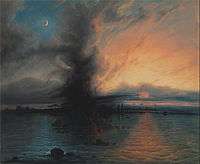Samuel Colman (British painter)
- For the American painter (1832–1920) see Samuel Colman
| Samuel Colman | |
|---|---|
| Born | 1780 |
| Died | 1920 |
| Nationality | British |
Samuel Colman, also Samuel Coleman, (1780‑1845) was an English painter, based in Bristol for most of his career.
Life
In about 1815 Colman moved from Yeovil to Bristol, where he lived until around 1840. He worked as a portrait painter and drawing-master in the city, as well as painting minutely detailed Romantic, Biblical and genre scenes.[1]

He was a religious Nonconformist who worshipped at the Castle Green Independent Chapel and the Zion Chapel in Bedminster, and his faith was central to his work;[1] some of his paintings, such as his The Destruction of the Temple (Tate Gallery), which shows the ruination of a Gothic cathedral, being criticisms of the Church of England.[2] His apocalyptic paintings have drawn comparisons to the works of John Martin.[3]
He signed works as Colman and alternatively Coleman.
External links and references
- 1 2 "Samuel Colman Saint James's Fair, detail". Bristol Museum & Art Gallery. Retrieved 18 March 2016.
- ↑ "Samuel Colman at the Tate". Retrieved 12 September 2013.
- ↑ "Samuel Colman Brief Bio". Retrieved 12 September 2013.
| Wikimedia Commons has media related to Samuel Colman. |